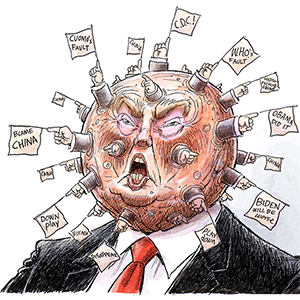Editorial: Obamacare is more popular and costlier than ever
Published in Op Eds
A rude surprise could be in store for the millions of Americans who get health coverage through the Affordable Care Act. If Congress doesn’t act next year, enhanced premium subsidies will expire by December, causing enrollees’ payments to increase by more than 75% on average.
Officials estimate more than 2 million people will become uninsured in the first year after the policy lapses. Extending the enhanced subsidies, meanwhile, would cost taxpayers $335 billion through 2034.
Politics aside, the brewing dilemma presents an opportunity for compromise that should involve extending the enhanced subsidies temporarily while gradually weaning the program from massive federal support. Both political parties might find such an agreement would work to their advantage.
Obamacare, passed in 2010, has expanded health coverage to 45 million Americans. In the decade since its implementation, the uninsured rate has roughly halved, to 8.2%. The ACA has become increasingly popular in recent years, largely thanks to provisions that prevent insurers from denying coverage based on preexisting conditions or charging sick people more for their plans.
But from the start, Obamacare has been dogged by two related problems: the web of mandates, taxes and fees required to make it work, as well as the program’s spiraling costs. Republicans spent years trying to repeal the law and successfully rolled back the provisions they found most objectionable — including the penalty for people who don’t have insurance and the mandatory expansion of Medicaid. Yet predictably, costs have soared. The average benchmark premium will rise to $497 next year from $273 in 2014, with the out-of-pocket maximum for a family at $18,400.
Obamacare has always subsidized most premiums. With the onset of the COVID-19 pandemic, Congress both increased and expanded these benefits to more enrollees, notably removing the “cliff” for incomes above 400% of the federal poverty level ($60,240 for individuals and $124,800 for a family of four). The Inflation Reduction Act extended these provisions through 2025. Largely as a result, enrollment surged to 21 million from 12 million in three years. More than 90% of enrollees qualify for subsidies.
The prospect of abruptly changing these settings and increasing premiums shouldn’t be taken lightly. Health-care costs in the U.S. are exceptionally high even with insurance; for the uninsured, the decision to forgo treatment can be deadly.
Enrollees most in need of help — those below 250% of the poverty line — should retain generous subsidies permanently. For richer participants, scaling back and then phasing out subsidies makes sense. The costliest outlays are enjoyed by enrollees above 400% of the FPL — that is, families with six-figure salaries.
This transition will not be politically painless, but putting Obamacare on a more sustainable path is essential. States can start by using a so-called 1332 waiver to reduce premiums. Such provisions allow states to bypass certain requirements of the ACA, so long as they provide comparable coverage and meet certain criteria.
So far, 15 states have used 1332 waivers to develop reinsurance programs, which lowered cost of coverage among earlier adopters by 20% on average in the first year. States might also consider ways to restructure risk pools for higher earners without raising costs for sicker patients. For example, dividing pools by health status would reduce costs for healthier enrollees and enable states to target subsidies to sicker ones.
For Republicans, allowing the subsidies to expire may be tempting. Yet drastic changes to health coverage are bound to be unpopular. Democrats, for their part, should recognize that such generous subsidies can’t be extended indefinitely. A more fiscally sustainable program will secure affordable coverage for the low- to middle-income Americans the ACA was designed to help.
The Affordable Care Act has expanded coverage to millions of Americans. Making the program affordable for enrollees and taxpayers alike would be an equally important legacy.
_____
The Editorial Board publishes the views of the editors across a range of national and global affairs.
_____
©2024 Bloomberg L.P. Visit bloomberg.com/opinion. Distributed by Tribune Content Agency, LLC.




























































Comments